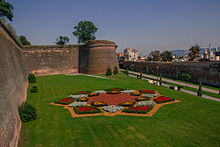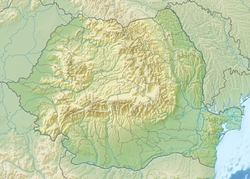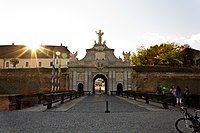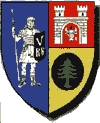Alba Iulia
Alba Iulia | |
|---|---|
Porta Principalis Dextra Defense wall of the citadel The Union Museum Saint Michael Catholic Cathedral | |
 Location in Alba County | |
| Coordinates:46°4′1″N23°34′12″E/ 46.06694°N 23.57000°E | |
| Country | |
| County | Alba |
| Government | |
| • Mayor | Gabriel Pleșa[1](2020–2024) (USR PLUS) |
| Area | |
| • Total | 103.65 km2(40.02 sq mi) |
| Population (2021-12-01)[2] | |
| • Total | 64,227 |
| • Density | 620/km2(1,600/sq mi) |
| Time zone | UTC+2(EET) |
| • Summer (DST) | UTC+3(EEST) |
| Website | www |
Alba Iulia(Romanian pronunciation:[ˌalbaˈjuli.a];German:KarlsburgorCarlsburg,formerlyWeißenburg;Hungarian:Gyulafehérvár;Latin:Apulum[3]) is a city that serves as the seat ofAlba Countyin the west-central part ofRomania.Located on the riverMureșin the historical region ofTransylvania,it has a population of 63,536 (as of 2011[update][update]).[4]
During ancient times, the site was the location of the Roman campApulum.Since theHigh Middle Ages,the city has been the seat of Transylvania'sRoman Catholic diocese.Between 1526 and 1570 it was the capital of theEastern Hungarian Kingdomfrom which thePrincipality of Transylvaniaemerged by theTreaty of Speyerin 1570 and it was the capital of thePrincipality of Transylvaniauntil 1711. At one point it also was a center of the Eastern Orthodox Metropolitan of Transylvania withsuffragantoVaddiocese.[5][6]On 1 December 1918, theUnion of Transylvania with Romaniawas declared in Alba Iulia, and the Romania'sKing Ferdinand IandQueen Mariewere crowned in theAlba Iulia Orthodox Cathedral,in 1922.[7]
Alba Iulia is historically important forRomanians,Hungarians,andTransylvanian Saxons.In December 1918, Alba Iulia was officially declaredCapital of theGreat Union of Romania.[8]
The city administers four villages: Bărăbanț (Borbánd), Micești (Ompolykisfalud), Oarda (Alsóváradja), and Pâclișa (Poklos).[9]
Names
[edit]During theRoman periodthe settlement was calledApulum(from the DacianApoulon,mentioned byPtolemy).[10][11][12]When the settlement with its Roman ruins became the seat of a dukedom in the 10th century, the population may have beenSlavic.[13]From the 9th to the 11th centuries, the settlement bore the Slavic nameBălgrad(meaning "white castle" or "white town" ).[7][12][14]The old Romanian name of the town wasBălgrad,[15]which originated fromSlavic.
TheHungariannameGyulafehérváris a translation of the earlier Slavic form,[14]meaning "white castle of the Gyula"[16]meaning "white city of Julius".[14]Albais the Romanian feminine form of the word forwhite,andIulia( "Julius" ) refers toGyula II,a mid-10th-century Hungarian warlord who wasbaptizedinConstantinople.[12][14]
Under the influence of the Hungarian form, Gyulafehérvár, the town's Latin name eventually becameAlba JuliaorAlba Yulia.[11][17][18]Its modern Romanian name,Alba Iulia,is the adoption of this[12][17]that started to spread in Romanian in ordinary speech in the 18th century.[19]The modern name has been officially used since the town became part of Romania.[20]
The 16th-centuryGermanname wasWeyssenburg.[12]The Saxons later renamed the town toKarlsburg(Carlsburg)[21]in honour ofCharles VI(1685–1740).[12][22]InYiddishandHebrew,Karlsburgwas prevalent. InLadino,Carlosburgwas used.[10]Alba Carolinawas also a Medieval Latin form of its name.[10]
AmongRuthenians,the city was known asBilhorod( "white city" ).[5]
The city'sLatinname in the 10th century wasCivitatem Albam in Ereel.[23][clarification needed]The first part of the nameAlbadenotes the ruins of the Roman fortApulum,the pre-feudal white citadel.[14][24]Later in the Middle Ages, different names were used:Frank episcopus Belleggradienesisin 1071,Albae Civitatisin 1134,Belegradain 1153,Albensis Ultrasilvanusin 1177,eccl. Micahelisin 1199,Albe Transilvanein 1200,Albe Transsilvanein 1201,castrum Albensin 1206,canonicis Albensibusin 1213,Albensis eccl. Transsylvanein 1219,B. Michaelis arch. Transsilv.in 1231,Alba... Civitasin 1242,Alba sedes eptusin 1245,Alba Julain 1291,Feyrvarin 1572,Feyérvárin 1574,Weissenburgin 1576, Belugrad in 1579,Gyula Feyervárin 1619,Gyula Fehérvárin 1690 andKarlsburgin 1715.[23]
History
[edit]This sectionneeds additional citations forverification.(May 2013) |
Ancient times
[edit]
The modern city is located near the site of the importantDacianpolitical, economic and social centre ofApulon,which was mentioned by the ancient Greek geographerPtolemyand believed by some archaeologists to be the Dacian fortifications on top of Piatra Craivii.[25]After Dacia became a province of theRoman Empire,the capital ofDacia Apulensiswas established here, and the city was known asApulum.[26]Apulumwas the largest urban centre in Roman Dacia and was the seat of theXIII GeminaLegion.Apulumis the largestcastrumlocated in Romania, occupying 37.5 hectares (93 acres) (750 x 500 m2).
Middle Ages
[edit]
TheGesta Hungarorummentions a Hungarian regent named Jula or Geula—the maternal grandfather ofStephen I of Hungaryand lord [regent] of Transylvania—who built the capital of his dukedom there during the 10th century.Geulawas baptized in the Byzantine Empire and built around 950 in Alba Iulia the first church of Transylvania. The ruins of a church were discovered in 2011. According to Ioan Aurel Pop and other historians, here lived Hierotheos the first bishop of Transylvania,[27][28]who accompanied Geula back to Hungary after Geula had been baptized in Constantinople around 950.[29]
Analysis of the necropoles of the city prior to the 11th century show that they were used by a population different from the conquering Hungarians.[30]
After Stephen I adopted Catholicism, and the establishment of theCatholicTransylvanian bishopric, recent archaeological discoveries suggest that the first cathedral was built in the 11th century or possibly before. The present Catholic cathedral was built in the 12th or 13th century. In 1442,John Hunyadi,Voivode of Transylvania,used the citadel to prepare for a major battle against theOttoman Turks.The cathedral was enlarged during his reign and he was entombed there after his death.
Ottoman and Habsburg period
[edit]In 1542 — after the partition of the Kingdom of Hungary — Alba Iulia became the capital of Transylvania and some of its neighboring territories to the west (later known asPartium[31]), the autonomousPrincipality of Transylvania,and remained so until 1690. TheTreaty of Weissenburgwas signed in the town in 1551. During the reign of PrinceGábor Bethlen,the city reached a high point in its cultural history with the establishment of an academy. The formerOttoman Turkishequivalent wasErdel BelgradıorBelgrad-ı Erdel( "Belgrade of Transylvania" in English) where Erdel (Erdély) was added to prevent confusion withBelgratandArnavut Belgradı( "Albanian Belgrade" in Turkish, early name of Berat during Ottoman rule).
In 29 November 1599,Michael the Brave,Voivode ofWallachia,entered Alba Iulia following his victory in theBattle of Șelimbărand became Voivode of Transylvania. In 1600 he gained control ofMoldavia,uniting the principalities of Wallachia, Moldavia and Transylvania under his rule, which lasted for a year and a half until he was murdered in 1601, by GeneralGiorgio Basta's agents.
Alba Iulia became part of the Habsburg Monarchy in 1690. The fortressAlba Carolina,designed by architect Giovanni Morando Visconti, was built between 1716 and 1735, at the behest ofEmperor Charles VI of Habsburg.The leaders of theTransylvanian peasant rebellionwere executed in Alba Iulia in January 1785. Important milestones in the city's development include the creation of theBatthyaneum Libraryin 1780 and the arrival of the railway in the 19th century.
-
The Austrian Guard of the Citadel
-
Alba Iulia on a 1556 map
-
The Union Museum
20th and 21st centuries
[edit]At the end of World War I, representatives of the Romanian population of Transylvania, theNational Assembly of Romanians of Transylvania and Hungary,gathered in Alba Iulia on 1 December 1918 during the so-calledGreat National Assembly of Alba Iuliato proclaim theUnion of Transylvaniawith theKingdom of Romania.The representatives of theTransylvanian Saxonsdecided to join this declaration on 8 January 1919.
In 1922,Ferdinand I of Romaniawas symbolically crownedKing of Romaniain Alba Iulia. In October 2012, at the 90th anniversary of King Ferdinand's coronation, his great-granddaughterPrincess Margarita of Romaniavisited Alba Iulia to commemorate the event.
Jewish history
[edit]
The Jewish community, which was the first in Transylvania, was established in the 14th century.[32]A community was officially founded by permission of PrinceGabriel Bethlenin 1623.[32]The 18th century saw an influx ofAshkenazimfrom Hungary and Wallachia, as well as Sephardim. From 1754 to 1868, the town rabbi was the chief rabbi of Transylvania. A synagogue was built in 1840, with a Sephardic one following in 1874. Most local Jews in the 19th century worked in viticulture and bought land for growing vines; in the 20th century, they were mainly artisans. By 1930, the 1558 Jews of Alba Iulia represented nearly 13% of the town's population.[33]
In October 1940, during theNational Legionary State,theIron Guardterrorized local Jews. The following year, theIon Antonescuregime confiscated Jewish property and sent the men to forced labor. After World War II, the community was re-established but soon dwindled as Jews emigrated.[33]
Climate
[edit]Alba Iulia has ahumid continental climate(Dfain theKöppen climate classification).
| Climate data for Alba Iulia (coordinates:46°03′N23°33′E/ 46.050°N 23.550°E,elevation: 246masl.) | |||||||||||||
|---|---|---|---|---|---|---|---|---|---|---|---|---|---|
| Month | Jan | Feb | Mar | Apr | May | Jun | Jul | Aug | Sep | Oct | Nov | Dec | Year |
| Mean daily maximum °C (°F) | 3.2 (37.8) |
7.9 (46.2) |
12.8 (55.0) |
18.2 (64.8) |
22.6 (72.7) |
27.3 (81.1) |
29.4 (84.9) |
30.1 (86.2) |
24.9 (76.8) |
18.3 (64.9) |
10.4 (50.7) |
5.2 (41.4) |
17.5 (63.5) |
| Daily mean °C (°F) | −0.1 (31.8) |
3.4 (38.1) |
7.1 (44.8) |
11.8 (53.2) |
16.6 (61.9) |
21.1 (70.0) |
22.6 (72.7) |
23.0 (73.4) |
18.3 (64.9) |
12.3 (54.1) |
6.5 (43.7) |
2.4 (36.3) |
12.1 (53.7) |
| Mean daily minimum °C (°F) | −3.5 (25.7) |
−1.0 (30.2) |
1.4 (34.5) |
5.3 (41.5) |
10.5 (50.9) |
14.9 (58.8) |
15.9 (60.6) |
15.9 (60.6) |
11.8 (53.2) |
6.3 (43.3) |
2.7 (36.9) |
−0.4 (31.3) |
6.7 (44.0) |
| Averageprecipitationmm (inches) | 25.4 (1.00) |
25.0 (0.98) |
32.7 (1.29) |
37.5 (1.48) |
79.0 (3.11) |
106.1 (4.18) |
70.7 (2.78) |
49.9 (1.96) |
42.5 (1.67) |
34.7 (1.37) |
39.3 (1.55) |
30.1 (1.19) |
572.9 (22.56) |
| Average precipitation days(≥ 0.1 mm) | 12.7 | 11.4 | 11 | 10.4 | 15.8 | 13.6 | 11.3 | 8.4 | 9.2 | 9.2 | 12.9 | 11.9 | 137.8 |
| Average snowy days | 6.2 | 2.3 | 2.1 | 0.6 | 0 | 0 | 0 | 0 | 0 | 0 | 1.2 | 3.2 | 15.6 |
| Source: Meteomanz (2014-2023)[34] | |||||||||||||
Landmarks
[edit]



The main historical area of Alba Iulia is the Upper Town region, developed byCharles VI, Holy Roman Emperorin honour of whom theHabsburgsrenamed the city Karlsburg. The fortress, with seven bastions in a stellar shape, was constructed between 1716 and 1735 by two Swiss fortification architects. The first wasGiovanni Morandi Visconti,who built two old Italian-style bastions. The second wasNicolaus Doxat de Demoret—nicknamed "AustrianVauban".After 1720, the two architects radically transformed the medieval fortress shaped by the former Roman castrum into a seven-bastion baroque fortress, developing Menno van Coehorn's new Dutch system, of which the fortress of Alba Iulia is the best preserved example.
Inside the fortress are The Union Hall with the National Honour Gallery, The National History Museum of Unification, the Princely Palace (Voivodal Palace), the Orthodox cathedral, the Roman Catholic cathedral, the Batthyaneum Library, the Roman Catholic bishop's palace, the Apor Palace, and theUniversity of Alba Iulia.Built in the 10th and 11th centuries, the Roman Catholic cathedral is the most representative building in the medievalRomanicstyle in Transylvania, and is considered to be an important monument of early Transylvanian medieval architecture. The tombs of John Hunyadi andIsabella Jagiełło—Queen of Hungary are located there.
TheBatthyaneum Libraryis held in a former church built in Baroque style. In 1780,Ignác Batthyány,bishop of Transylvania, adapted the inside of the building for use as a library. It is famous for its series of manuscripts,incunabulaand rare books—such as half of the 9th centuryCodex Aureus of Lorsch,the 15th centuryCodex Burgundusand the 13th centuryBiblia Sacra(13th century). The first astronomical observatory in Transylvania was founded here in 1792. The Apor Palace, situated on the same street as the Bathyaneum Library, belonged to Prince Apor and was built in the second half of the 17th century. At the beginning of the 18th century, it was the residence of the Austrian army leader Prince Steinville. The palace was renovated in 2007 under the supervision of the Romanian Ministry of Culture.
The Orthodox Unification Cathedral was built between 1921 and 1923, following the plans of architect D.G. Ștefănescu and built under the supervision of eng. T. Eremia. The frescoes were painted byConstantinin a traditional iconographic style. The first monarchs of the Unified Romania, King Ferdinand I andQueen Mariewere crowned in the cathedral on 15 October 1922.
The National Museum of Unification in Alba Iulia is located in the "Babylon" Building. It was built between 1851 and 1853 for military purposes and became a museum in 1887. The museum exhibits over 130,000 pieces of artworks, organized chronologically. The Unification Hall, also part of the National History Museum, retains historical significance from having hosted, on 1 December 1918, the rally of the 1228 Romanian delegations from Transylvania who determined the province's union with the Kingdom of Romania. The building was used in 1895 as a military casino.
The Princely Palace (Palatul Principilor or Palatul Voievodal) was Michael the Brave's residence during the first political unification of the Romanians in 1600. Foreign chronicles pictured it as an extremely luxurious building, richly adorned with frescos and marble stairs, which later deteriorated. During the rule of PrincesGábor BethlenandGeorge II Rákóczithe second palace was restored, but not to its previous condition. After 1716, the building was used as an Habsburg Imperial Army barracks.
Natives
[edit]- Francis I Rákóczi(1645–1676), elected prince of Transylvania
- Michael II Apafi(1676–1713), Prince of Transylvania 1690 to 1699
- Ernst Michael Mangel(1800–1887), musician andPhilhellene
- Rudolf Züllich(1813–1890), sculptor
- Alexandru Borza(1887–1971), botanist and monk
- Ernest Krausz(1931–2018), Israeli professor of sociology and President atBar Ilan University
- Dan Eugen Demco(1942–), physicist and member of theRomanian Academy
- Ion Mărgineanu(1949–), writer and poet
- Marius Moga(1981–), producer, composer, and singer
Other notable residents
[edit]- Johann Heinrich Alsted(1588–1638), German Calvinist minister and academic. Spent his last years and died there.
- David Friesenhausen(1756–1828), Jewish writer, mathematician, and rabbi. Retired and died there.[35]
Twin towns – sister cities
[edit] Aigio,Greece
Aigio,Greece Alcalá de Henares,Spain
Alcalá de Henares,Spain Alessandria,Italy
Alessandria,Italy Arnsberg,Germany
Arnsberg,Germany Biograd na Moru,Croatia
Biograd na Moru,Croatia Cetinje,Montenegro
Cetinje,Montenegro Chișinău,Moldova
Chișinău,Moldova Düzce,Turkey
Düzce,Turkey Lanzhou,China
Lanzhou,China Nof HaGalil,Israel
Nof HaGalil,Israel Sliven,Bulgaria
Sliven,Bulgaria Székesfehérvár,Hungary
Székesfehérvár,Hungary Varese,Italy
Varese,Italy Viadana,Italy
Viadana,Italy
Demographics
[edit]| Year | Pop. | ±% |
|---|---|---|
| 1850 | 5,408 | — |
| 1880 | 7,338 | +35.7% |
| 1890 | 8,167 | +11.3% |
| 1900 | 11,507 | +40.9% |
| 1912 | 11,616 | +0.9% |
| 1930 | 12,282 | +5.7% |
| 1948 | 14,420 | +17.4% |
| 1956 | 14,776 | +2.5% |
| 1966 | 22,215 | +50.3% |
| 1977 | 41,199 | +85.5% |
| 1992 | 71,168 | +72.7% |
| 2002 | 66,369 | −6.7% |
| 2011 | 63,536 | −4.3% |
| 2021 | 64,227 | +1.1% |
| Source: Census data | ||
According to the2021 census,there was a total population of 64,227 people living in this city. At the2011 census,there were 63,536 inhabitants; of these, 95.3% were ethnic Romanians, 3.2%Romani,1.9%Hungarians,and 0.2%Germans(more specificallyTransylvanian Saxons).[4]
In 1850, Alba Iulia had 5,408 inhabitants, 2,530 of them being Romanians (46.78%), 1,009 Hungarians (18.67%), 748 Germans/Transylvanian Saxons (13.83%), and 1,121 (20.73%) others.[37]
In 1891, the city had 8,167 residents, of which 3,482 were Hungarians (42.63%), 3,426 Romanians (41.94%), and 867 Germans/Transylvanian Saxons (10.62%).[38]By 1910 the number of inhabitants increased to 11,616. 5,226 of them were Hungarians (45%), 5,170 Romanians (44.51%), and 792 Germans/Transylvanian Saxons (6.82%).[39]At the 1930 census, 34.7% of the population were Romanian Orthodox, 28.1%Romanian Greek Catholic,12.9% Roman Catholic, 12.7% Jews, 7.3% Reformed Protestant, and 3.1% Lutheran.[40]
Panoramas
[edit]Image gallery
[edit]-
Unirii Museum
-
Obelisk of Horea, Cloșca, and Crișan
-
Gate I
-
Gate III
-
Unirii Hall, view from Custozza Park
-
Cannon fire by the citadel's Austrian guard
-
Michael the Brave Statue
-
Piața Unirii (Union Square)
Citations
[edit]- ^"Results of the 2020 local elections".Central Electoral Bureau. Archived fromthe originalon 9 October 2020.Retrieved6 June2021.
- ^"Populaţia rezidentă după grupa de vârstă, pe județe și municipii, orașe, comune, la 1 decembrie 2021"(XLS).National Institute of Statistics.
- ^Encyclopædia Britannica|"Alba-Iulia"
- ^ab"Comunicat de presă privind rezultatele provizorii ale Recensământului Populaţiei şi Locuinţelor – 2011"(PDF).Alba County Regional Statistics Directorate. 2 February 2012. Archived fromthe original(PDF)on 18 April 2013.Retrieved14 February2012.
- ^abMaksym Mayorov.Metropolitan of Kiev and other Eastern Orthodox Churches before 1686 (Київська митрополія та інші православні церкви перед 1686 роком ).Likbez. 16 December 2018
- ^The Metropolitan Cathedral of ClujArchived19 April 2019 at theWayback Machine.Transylvania and Beyond.
- ^ab"Alba Iulia".britannica.com.Encyclopædia Britannica.Retrieved22 June2022.
- ^Iaşi desemnat "Capitală istorică", iar Alba Iulia "Capitală a Marii Uniri"
- ^"State Of Play Report Alba Iulila Municipality"(PDF).
- ^abc"ALBA IULIA".Jewish Virtual Library.Retrieved26 December2012.
- ^abJarig Bakker (10 February 2001)."Alba Iulia (Romania, Alba)".CRW Flags.Retrieved18 October2013.
- ^abcdefPatrick Leigh Fermor, Between the woods and the water: on foot to Constantipole from the Hook of Holland: the middle Danube to the Iron Gates, Viking, 1986, p. 138,ISBN9780670811496,Citations: "The Dacian Apulon became the Latin Apulum, and the place was full of traces of the old Roman colony. But both of these words were silenced when the hushed and muffling spread of the Slavs stifled the old names of Eastern Europe forever. They renamed itBălgrad- the white town (one of many) - perhaps because of its pale walls and this white motif caught on. The Saxons called it Weissenburg and later Karlsburg, in honour of Emperor Charles VI, who built the great eighteenth-century fortress here. The Hungarians had already adopted the notion of whiteness, but another crept in too: the word 'Julius', after a mid-tenth-century (Hungarian?) prince who had visited Constantinople and been baptised there. In Hungarian, Gyulafehérvár, means "white city of Gyula". The Rumanians stuck to Bălgrad, then adopted the medieval Latin name of Alba Iulia. "
- ^Makkai 2001, p. 365
- ^abcdeAdrian Room,Placenames of the World: Origins And Meanings of the Names for 6,600 Countries, Cities, Territories, Natural Features and Historic Sites,McFarland, 2006, p. 23
- ^"Christianization in Early Medieval Transylvania: A Church Discovered in Alba Iulia and its Interpretations",Christianization in Early Medieval Transylvania,Brill, p. 11, 20 June 2022,ISBN978-90-04-51586-4,retrieved13 March2024
- ^Iván Boldizsár,NHQ; the New Hungarian Quarterly, Volume 29; Volumes 109-110,Lapkiadó Publishing House, 1988, p. 73
- ^abKiss, Lajos (1980).Földrajzi nevek etimológiai szótára.Budapest:Akadémiai Kiadó.p. 256.ISBN963-05-2277-2.
- ^Medieval and Early Modern for Central and Eastern EuropeAlexandru Ioan Cuza University, Alexandru Ioan Cuza University Press, p. 196
- ^László Bányai,Közös sors--testvéri hagyományok: történelmi vázlat,Politikai Könyvkiadó, 1973, p. 41, Citations: "A középkori latin okiratok Alba Iulia-ja csak a XVIII. századtól terjed el a román köznyelvben" Translation: "the term 'Alba Iulia', used in medieval Latin charters, started to spread in the Romanian vulgar tongue only in the 18th century"
- ^Magyar történeti tanulmányok, Volumes 19-21, Acta Universitatis Debreceniensis de Ludovico Kossuth nominatae: Series historica,KLTE, 1986, p. 85 Citations: "Itt említjük meg, hogy Gyulafehérvárat akkoriban románul Belgrad-nak hívták, csak Romániához történt csatolása után lett belôle Alba Iulia." Translation: "We mention it here that Gyulafehérvár was called Belgrad in Romanian and it turned to Alba Iulia after it became part of Romania."
- ^Berichte und Forschungen. Jahrbuch des Bundesinstituts für Kultur und Geschichte der Deutschen im Östlichen Europa 11/2003,p.137
- ^The Transylvanian Saxons: historical highlights,Alliance of Transylvanian Saxons, 1982, p. 55,ISBN9783853730706
- ^abFerenc Léstyán,MEGSZENTELT KÖVEK A KÖZÉPKORI ERDÉLYI PÜSPÖKSÉG TEMPLOMAI,Roman Catholic Archdiocese of Alba Iulia, 2000,ISBN973-9203-56-6
- ^Romania in brief,Meridiane Pub. House, 1966, p. 74
- ^"Alba Iulia Online".Apulum.ro. Archived fromthe originalon 11 February 2012.Retrieved25 March2013.
- ^"Apulum @Livius.orgl".Archived fromthe originalon 26 October 2006.Retrieved26 March2020.
- ^Ioan Aurel Pop, Jan Nicolae, Ovidiu Panaite, Sfântul Ierotei, episcop de Alba Iulia (sec. X). Edit. Reîntregirea, 2010, 335 p
- ^I. Strajan, Adevărul istoric a învins la Alba Iulia, Despre prima organizare creştină din Transylvania – sec. X, "DACOROMANIA" nr.55/2011
- ^Curta, Florin(2006).Southeastern Europe in the Middle Ages, 500-1250.Cambridge University Press. pp.189-189.ISBN978-0-521-89452-4.
- ^Gáll, Erwin (2010)."An analysis of the Cemeteries from the 10th and 11th Centuries in Brânduşei Street, Alba Iulia (Gyulafehérvár, Karlsburg). New theories on the migration of People in Transylvania in the 10 th -11th Centuries".academia.edu.Retrieved3 May2024.
- ^Keul, István (2009).Early modern religious communities in East-Central Europe: Ethnic Diversity, Denominational Plurality, and Corporative Politics in the Principality of Transylvania (1526–1691).Leiden:Brill Publishers.pp. 40–41.ISBN978-90-04-17652-2.
- ^abGyémánt, Ladislau (December 2012)."The Transylvanian Jewish Identity's Avatars in the Epoch of Emancipation"(PDF).Studia Universitatis Babeş-Bolyai, Historia.57(Transylvanian Identities in the Modern Epoch).
- ^abShmuel Spector, Geoffrey Wigoder (eds.),The Encyclopedia of Jewish Life Before and During the Holocaust: A—J,p. 25.New York University Press,2001,ISBN0-8147-9376-2
- ^"Alba lulia - Weather data by months".meteomanz.Retrieved7 July2024.
- ^Silber, Michael K."Friesenhausen, David".YIVO.Retrieved9 August2014.
- ^"Orașe înfrățite cu Alba Iulia".apulum.ro(in Romanian). Alba Iulia.Retrieved18 October2022.
- ^"ERDÉLY ETNIKAI ÉS FELEKEZETI STATISZTIKÁJA"(PDF).Archived fromthe original(PDF)on 22 May 2011.Retrieved8 April2019.
- ^Gyulafehérvár.A Pallas nagy lexikona.Hungarian Electronic Library (MEK).
- ^Gyulafehérvár.Révai Nagylexikona, vol. 9.p. 237. Hungarian Electronic Library.
- ^Recensământul general al populației României din 29 Decemvrie 1930, vol. II, p. 522.
Secondary sources
[edit]- Makkai, László (2001). "Transylvania in the medieval Hungarian kingdom (896–1526)", In: Béla Köpeczi,Historyof Transylvania Volume I: From the Beginnings to 1606,Columbia University Press, New York, 2001,ISBN0880334797
External links
[edit]- Official site
- Alba Iulia photo gallery(in Romanian)























